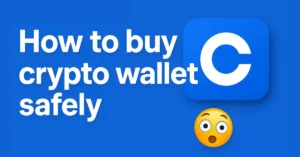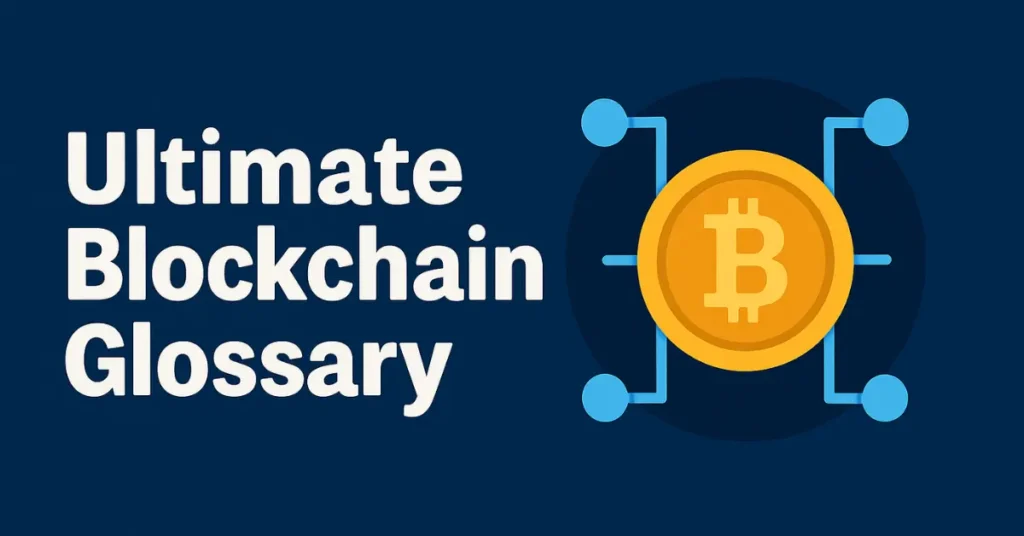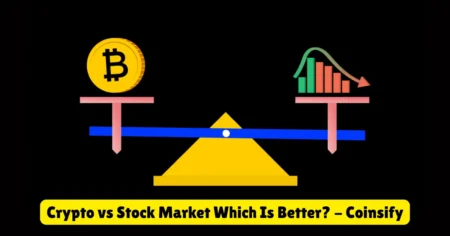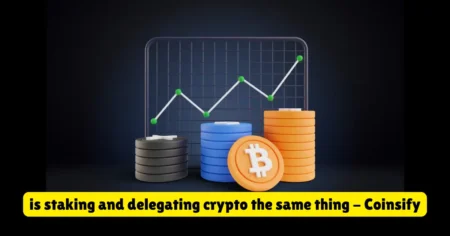Ultimate Blockchain Glossary.
Introduction: What is Blockchain?
Blockchain is a decentralized digital ledger that records transactions securely, transparently, and immutably. Each block contains a record of transactions, a timestamp, and a reference to the previous block, forming a continuous chain.
Key Features of Blockchain
- Decentralization: No single authority controls the network.
- Immutability: Once recorded, data cannot be altered.
- Transparency: Public blockchains allow anyone to verify transactions.
- Security: Cryptographic techniques ensure the data remains secure.
Cryptocurrencies: The Digital Assets
Cryptocurrencies like Bitcoin and Ethereum operate on blockchain technology. These digital currencies are decentralized and not governed by any central authority or government.
Crypto Wallets: Your Digital Key
- Public Key: Your blockchain address, similar to a bank account number.
- Private Key: A secret password to access and control your funds.
- Hot Wallets: Wallets connected to the internet, like mobile apps.
- Cold Wallets: Offline wallets such as hardware wallets, offering higher security.
Important: Never share your private key. Losing it means losing access to your funds permanently.
How Transactions Work on Blockchain
- A user creates and digitally signs a transaction using a private key.
- The transaction is broadcasted to the network.
- Nodes validate the transaction.
- Validated transactions are added to a new block.
- The new block is permanently recorded on the blockchain.
Consensus mechanisms like Proof-of-Work (PoW) and Proof-of-Stake (PoS) are used to secure the blockchain network.
Mining vs Staking
| Mining (Proof-of-Work) | Staking (Proof-of-Stake) |
| High energy consumption | Low energy consumption |
| Complex hardware requirement | Simple coin staking |
| Mining rewards through solving puzzles | Staking rewards through holding crypto |
Smart Contracts: The Game Changer
Smart contracts are self-executing programs that automatically enforce agreements once conditions are met. They eliminate the need for third-party involvement.
Example: In an insurance smart contract, if the agreed condition is met, payment is automatically processed.
DeFi (Decentralized Finance)
DeFi shifts traditional financial services like banking, lending, and trading onto decentralized platforms without intermediaries.
Popular DeFi services:
- Lending aur borrowing platforms
- Decentralized Exchanges (DEXs)
- Yield farming aur liquidity mining
NFTs (Non-Fungible Tokens)
NFTs are unique digital assets existing on the blockchain. Each NFT has a distinct ID and proof of ownership. NFTs are widely used in art, music, gaming, and digital collectibles.
| Advantages of Blockchain | Disadvantages of Blockchain |
| Immutability | Scalability issues |
| Decentralization | High energy consumption (PoW) |
| Transparency | Privacy concerns |
| Enhanced security | Regulatory uncertainty |
| Fast cross-border transactions | Irreversible transactions |
| Smart contract functionality | User complexity aur key management ka risk |
Step-by-Step Guide: Ultimate Blockchain Glossary

Step 1: Understand the Purpose of a Glossary
First, know that a glossary is a collection of important terms and their simple explanations, especially useful for complex topics like blockchain.
Step 2: Organize the Glossary Alphabetically
- Arrange all terms alphabetically (A to Z).
- This makes it easier for readers to quickly find and understand specific blockchain concepts.
Example:
- A – Address
- B – Blockchain
- C – Consensus
Step 3: Define Each Term Clearly and Simply
- Write short, clear definitions for each term.
- Avoid complicated language so that even beginners can understand.
Example:
- Blockchain: A digital system for recording transactions that cannot be altered once confirmed.
- Cryptography: The process of securing information using codes.
Step 4: Include Short Examples Where Necessary
If a term is complex, add a simple example to make it easier to understand.
Example:
- Smart Contract: A computer program stored on the blockchain that automatically runs when conditions are met.
- Example: Payment is automatically sent once a product is delivered.
Step 5: Cover All Essential Terms
Make sure to include both common and important blockchain terms such as:
- Address
- Blockchain
- Consensus
- Decentralization
- Wallet
- Private Key
- Mining
- Token
- NFT
- Gas Fees
Step 6: Maintain Consistent Formatting
Keep a consistent format for every term:
- Bold the term name.
- Follow it with a simple, clear definition.
- Add examples only if needed.
Example: Mining: The act of validating blockchain transactions and earning cryptocurrency rewards.
Step 7: Keep the Language Simple and Accessible
- Avoid technical jargon or overly complex sentences.
- Your goal is for both beginners and intermediate readers to easily follow along.
Instead of:
- “Blockchain is an immutable decentralized ledger operating through consensus mechanisms.”
Use:
- “Blockchain is a shared system where no one can change the transaction records, managed by a network of users.”
Step 8: Regularly Update the Glossary
Since blockchain is a rapidly evolving field, make sure to update the glossary regularly by adding new terms like:
- Web3
- zk-Rollups
- Layer 2 solutions
- DAOs (Decentralized Autonomous Organizations)
Step 9: Add Internal Links (Optional for SEO)
If you are posting on a website, you can link some glossary terms to your other detailed blog posts.
This helps readers explore more and improves your website’s SEO.
Example:
- Word: Smart Contract → Link to your article: “How Smart Contracts Work”
Step 10: Conclude with a Brief Closing
At the end of the glossary, add a short and motivating conclusion.
Example:
“This Blockchain Glossary gives you a solid foundation to understand blockchain technology. Keep exploring and growing in the world of crypto.”
FAQs About Blockchain
What is Blockchain?
Blockchain is a secure, decentralized ledger system that records transactions across multiple computers.
How do cryptocurrencies work?
They use blockchain networks where transactions are verified through public and private keys and consensus algorithms.
What is a crypto wallet?
A digital tool that stores your private and public keys and interacts with different blockchains.
What is the difference between mining and staking?
Mining requires solving complex problems to validate transactions; staking involves locking coins to support the network and earn rewards.
What are Smart Contracts?
They are programs that automatically execute and enforce the terms of an agreement without human involvement.
What is DeFi?
DeFi provides decentralized financial services using blockchain, eliminating the need for banks or brokers.
What are NFTs?
NFTs are unique tokens that represent ownership of a specific digital or real-world item on the blockchain.
Is Blockchain secure?
Yes, but users must securely manage their private keys to prevent unauthorized access.
Conclusion
Blockchain technology is revolutionizing digital transactions and asset management. With its transparency, security, and decentralization, blockchain is influencing sectors like finance, healthcare, real estate, and education. Learning and understanding blockchain is essential to becoming part of this rapidly evolving world.
Bonus Points for Creating an Ultimate Blockchain Glossary
Add Visuals (Optional but Effective)
- Use simple charts, icons, or infographics to explain difficult terms.
- Visuals help readers understand faster and keep them engaged for longer.
Create a Search Bar (If Possible)
- If your glossary gets very big, having a small search bar can help users find specific terms easily.
- Improves user experience (UX) and keeps your bounce rate low.
Offer a Downloadable PDF Version
- Give visitors the option to download the glossary as a free PDF.
- This builds trust and increases chances they will revisit your website.
Include Related Terms Together
- If some terms are related, mention them together.
- Example: Under “Blockchain,” you can mention terms like “Decentralization” and “Consensus Mechanism” as related concepts.
Use Real-World Examples
- Whenever possible, add small real-life examples.
- It makes abstract blockchain concepts feel more practical and relatable.
Optimize for Featured Snippets
- Structure definitions clearly and concisely so Google might pick your terms for featured snippets.
- Featured snippets = more traffic!
Update with Latest Blockchain Trends
Keep updating your glossary with new blockchain innovations like:
- DeFi (Decentralized Finance)
- Metaverse
- Web3
- Layer 2 solutions
- CBDCs (Central Bank Digital Currencies)
Mobile Friendly Formatting
- Ensure your glossary looks good and scrolls easily on mobile devices.
- Most users now browse on smartphones — mobile optimization is crucial.
Encourage Sharing
- Add share buttons so people can easily share specific terms or your full glossary on social media.
- More shares = more visibility = more organic traffic.
Use Easy-to-Read Fonts and Proper Spacing
- Avoid heavy or fancy fonts that are hard to read.
- Good spacing between terms and definitions helps in better readability.






